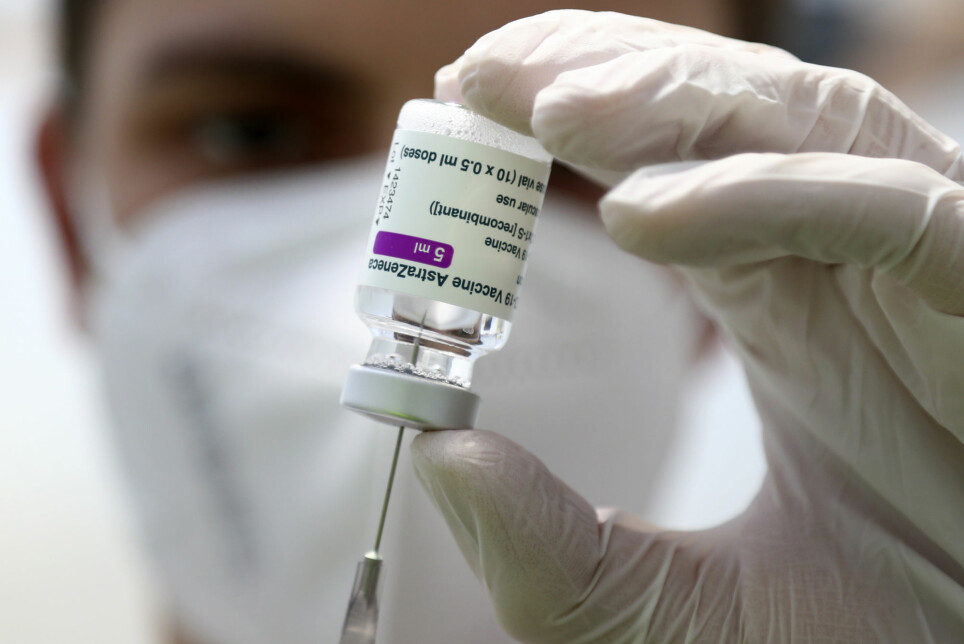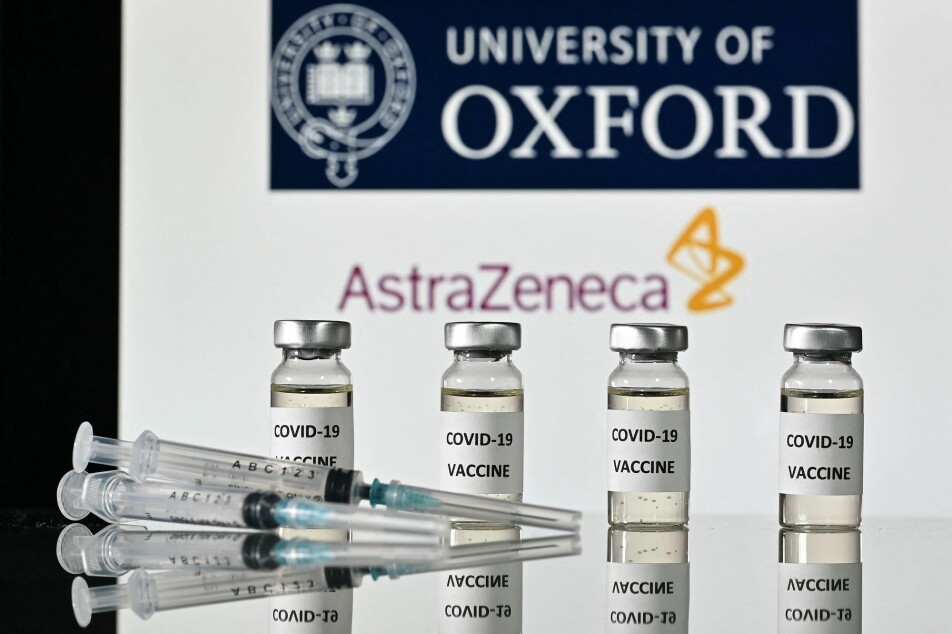
Rare side effects from the AstraZeneca and Johnson & Johnson vaccines may have been seen in 15 year old animal studies
That a high dosage of adenovirus in the bloodstream could lead to clotting, low levels of platelets and antibodies to platelets was known 20 years ago from animal studies in gene therapy.
Norwegian biologist Gro Amdam writes this in an email to ScienceNorway from the USA, where she is professor at Arizona State University.
“Studies on animals showed this – in experiments on monkeys, rabbits and mice. The problem became an obstacle for research and development of gene therapy,” Amdam writes.
The AstraZeneca vaccine against Covid uses a so-called adenoviral vector to deliver the vaccine in our bodies.
Several cases of unusual and serious cases of clotting combined with low levels of platelets and bleeding after the vaccine – four with a fatal outcome – caused Norway to pause the use of the AztraZenea vaccine on March 11.
Norwegian researchers recently explained what happened to these patients in a paper published in the New England Journal of Medicine. They have given the syndrome the name VITT – Vaccine-induced immune thrombocytopenia.
But it turns out this condition hasn’t been entirely unknown. At least not for those who spent years doing research on adenoviruses as vectors in animals some 15-20 years ago.
“The syndrome of low platelets and clotting was well known within the disciplines that used adenoviral vectors at that time,” Amdam writes.
When the condition now is presented as a mystery, she wonders if this knowledge has been forgotten.

Adenovirus caused low levels of platelets in mice
In the neighbouring country of Canada, professor Maha Othman has been thinking about the same thing.
Othman is a professor at Queen's University, and an expert in all things blood related – bleeding and clotting being her specialties. 15 years ago, she was one of those researchers Amdam is talking about.
In the 90s, using adenovirus for gene therapy was considered the next big thing. But then 18-year old Jessie Gelsinger died in 1999, during a clinical trial using an adenovirus vector to deliver gene therapy.
Everything was put on hold, and researchers spent the next ten years understanding the immune response to the adenovirus.
Specializing in bleeding and clotting, Othman was looking at the effect the technology had on platelets - small, colourless cell fragments in our blood that form clots and stop or prevent bleeding.
Adenoviruses are viruses that can and do cause respiratory disease. However, when used as vectors, they have been stripped with all of those abilities. The genes that make them replicate in our cells are removed.
This is called a replication deficient virus – and thus it should not cause disease.
“However, it is important to note that these replication deficient viruses can still elicit innate immune responses which can affect platelets and coagulation”, Othman says.
In her own study, replication deficient virus was given to mice. Within 24 hours it led to low levels of platelets.
Related to protein important for clotting
The adenovirus was shown to activate the platelets in the mice. Activated platelets trigger coagulation and so must be removed from circulation – hence the number of platelets is reduced.
Othman discovered that the adenovirus entered the platelets with the help of a specific receptor known as CAR, Coxsackievirus and adenovirus receptor, which mediates the entry of the virus into the cells in our bodies.
The process was also related to the release of a sticky protein important for clotting, known as ultra-large multimers of VWF .
So what does this tell us?
“It tells us that thrombocytopenia may be adenovirus induced, and that activation of coagulation and thrombosis may also be adenovirus induced”, Othman says.
“I won’t be surprised if later on, experiments prove that this rare side effect is due to the adenovirus itself. In any case it could be a factor, and it’s worth studying”, she says.
Othman is one of 105 experts in the field who discuss the issue of the AztraZeneca side effects in an email group on a daily basis. So far, the group has talked mostly about the findings around VITT. The professor hopes to also bring the adenoviral vector on board as a topic.
Some have highlighted that the AstraZeneca and the Johnson & Johnson vaccine use different types of adenoviruses.
“But regardless, the process by which they would enter the cells or blood platelet would be the same, so the process of activating the platelets remains possible”, Othman says.
Didn't immediately make the connection
Also immunologist and vaccine researcher Gunnveig Grødeland at the University of Oslo believes that studies and observations point in the direction of the unusual blood clots being caused by the adenoviruses. Commenting on a Norwegian study on mild bleedings as a side effect of the AztraZeneca vaccine, she said to sciencenorway.no that “It is starting to become clear that these side effects most likely are caused by characteristics from the adenoviral vector used to deliver the vaccine”.
When the unusual cases of blood clots combined with low levels of platelets and bleeding after the AstraZeneca vaccine, Maha Othman didn’t immediately connect this to her earlier animal studies.
“I spent 3 years working on this. I grew adenoviruses in the lab and injected mice with them to study effects on platelets and coagulation but it still didn’t click until a couple of weeks ago, when VITT was reported also in association with the Johnson & Johnson vaccine; a second adenoviral based vaccine", she says.
Othman worries about the impact of this information on the public and millions of people waiting to take these vaccines.
“They are going to say doesn’t that mean it’s dangerous, and why didn’t people stop it. But according to current reports, so far this remains rare. I still believe the benefits of vaccination outweigh the risks as things stand”, she says.
By no means a certain connection
But the connection between animal studies such as the ones Othman conducted and the rare side effects is not clear or obvious. Othman and several other researchers sciencenorway.no has spoken to stress this.
The animals in the study received considerably larger doses of adenovirus than the small amount found in the vaccine. The animals also had the doses delivered straight into the blood, while the vaccine is injected in the muscle.
“The dose is different than the one we used. The route of administration different. The species is different – mice are not men. And the adenoviruses are different – AstraZeneca uses a different serotype than Johnson & Johnson”, Othman says.
It is by no means certain that the patients described with VITT have had a reaction to the adenovirus. More studies are needed to look into this, according to Othman.
“But it is possible that thrombocytopenia, the low levels of platelets described in VITT associated with these two types of vaccines is adenovirus induced,” she says.
“This side effect may be a surprise to some people, but for others, we knew about this and we saw it 14 years ago,” Othman says.

Thinks none of the animal studies give reason to doubt
“We still don’t know exactly what the connection is between the rare blood clot condition and the vaccine. There is still a lot of uncertainty”, says Tor Kristian Andersen.
Andersen is an immunologist and vaccine researcher at Oslo University Hospital.
He acknowledges that the similarities in the side effects from the animals are striking.
“At the same time, the doctors at Oslo University Hospital who published their findings on these side effects have concluded that it’s most likely a vaccine induced disturbance in the platelets which is similar to a condition we know from a rare and adverse response to the blood thinner heparin. It’s difficult to compare this to the results from the animal studies on gene therapy with adenoviral vectors”, he says.
Andersen also stresses the dosage of adenovirus contained in the vaccines, and that the vaccine is administered in a muscle and not directly into the bloodstream.
“That you get an adverse response when something is given intravenously is not comparable to injecting a vaccine”, he says.
“All the safety studies leading up to the mass vaccination suggests that the vaccine is safe, so the side effect is extremely rare.”
When taken together, the earlier animal studies and the new VITT syndrome, suggest that an adenoviral vector could have this adverse effect in certain situations, according to Andersen.
“But none of those animal studies give reason to doubt that it was a good idea to use an adenoviral vector as a vaccine”, he stresses.
“It’s not like the researchers should have looked more closely at this or that they should have held back the vaccine development”, Andersen says to sciencenorway.no.
Health authorities were aware of the animal studies
The Norwegian Medicines Agency was aware of the animal studies that showed the link between the adenovirus and low levels of platelets and blood coagulation.
But the studies weren’t part of the agency’s assessment of the AstraZeneca and Johnson&Johnson vaccines, according to Svein Rune Andersen. Andersen is the Scientific Director for vaccines at the Norwegian Medicines Agency.
The agency has a role in the European Medicines Agency’s safety committee . In a report on the AstraZeneca vaccine published April 8, the committee refers to one of Othmans studies from 2007.
Like the others ScienceNorway has spoken to, Andersen notes that the animal studies differ from what happens during a vaccination, where the dosage of adenovirus is much lower and is injected in a muscle.
“All animal data for AstraZeneca and the Johnson-vaccines have been thoroughly examined. They haven’t given reason to suspect that the vaccines cause an unwanted effect in people,” writes Andersen in an email to forskning.no.
The combination of blood clots, low levels of platelets and bleeding is extremely rare. This is one of the reasons why it wasn’t discovered in the clinical trials, according to Andersen.
Even though thousands of people participated in the trials, the side effect is so rare it wasn’t seen before the vaccine was used on the mass public.

AstraZeneca says they've upheld the highest standards of safety and ethics
ScienceNorway.no has reached out the pharmaceutical companies AstraZeneca and Johnson & Johnson in order to hear their view on these animal studies, seen in the light of the newly discovered side effects that may be caused by their vaccines.
"Further studies need to be undertaken to further inform the understanding of any potential relationship between COVID-19 vaccines and very rare blood clotting events that occur together with low platelet counts," writes Mathias Holm Pedersen, Communications Director for the Nordics at AstraZeneca, in an email to ScienceNorway.
The company is already working with researchers in Great Britain and Europa to map potential mechanisms, according to Pedersen.
"We are also working to examine healthcare databases where these types of events have previously been comprehensively recorded to understand whether the frequency of events is greater than would normally be observed in the general population. This work is ongoing," writes Pedersen.
Pedersen doesn't directly adress how the immune response to adenoviruses has been assessed. But he writes that even though their development programme has been conducted more rapidly than typical, they have upheld the highest standards of safety and ethics.
"An independent DSMB safety monitoring committee oversees the studies to ensure safety and quality. Data from the clinical trials of AstraZeneca COVID-19 vaccine conducted globally in over 60,000 participants did not reveal any safety issues of concern," writes Pedersen. A DSMB is a data and safety monitoring board.
Thorough studies as we go along
“We have to be patient and diligent in finding the answers, and not jump to conclusions. Efforts need to be combined, and we have to continue to look into all possibilities”, says professor Maha Othman at Queen's University.
She believes we need to continue to monitor the situation, gather data and conduct thorough studies as we go along.
“We need to study blood from VITT patients for antibody profile, platelet activation markers, inflammatory markers and so on”, she says.
What we know so far is that researchers have found elevated levels of antibodies to platelet factor 4 – but we don’t know why.
We also know that it occurs mostly in young people, which makes sense according to Othman, as immune response is stronger in younger age groups. And it seems to occur mostly in women – who are known to have stronger immune responses than men.
“So it’s an immune response. But why? Is it induced by the adenovirus? The fact that it is mostly young females supports this theory,” Othman says.
Johnson & Johnson did not respond to our request to comment on this story.
References:
Othman et al: Adenovirus-induced thrombocytopenia: the role of von Willebrand factor and P-selectin in mediating accelerated platelet clearance. Blood, 2007
M. Othman, A. Labelle, D. Lillicrap: Adenovirus Activates Mouse Platalets and Induces Platalets Leucocyte Association. Molecular Therapy, 2005
Othman et al: Platelet–adenovirus vs. inert particles interaction: Effect on aggregation and the role of platelet membrane receptors, Platelets, 2013
G. Cichon et al: Intravenous administration of recombinant adenoviruses causes thrombocytopenia, anemia and erythroblastosis in rabbits. Journal of Gene Medicine, 1999.
J. N. Lozier et al: Toxicity of a first-generation adenoviral vector in rhesus macaques (summary). Human Gene Therapy, 2002.
—
This article was updated on April 24 at 01:05 in order to include some parts that had not been translated into English from a Norwegian version of this article.



































